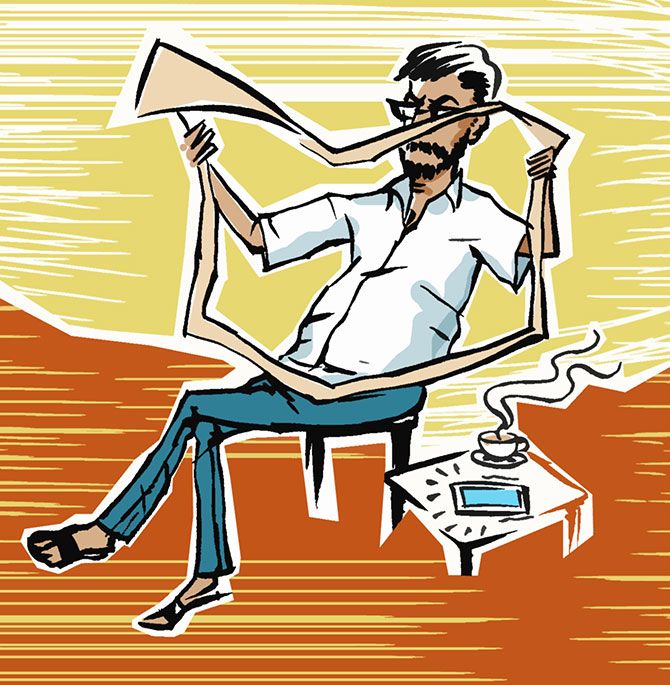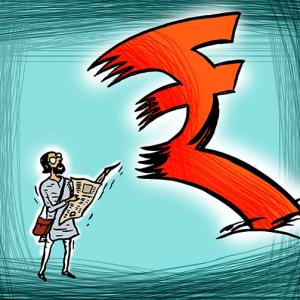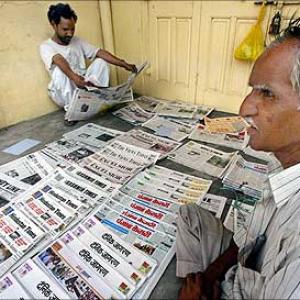'Demonetisation is just a trigger; the Indian print industry had this coming for years,' says Vanita Kohli-Khandekar.
Illustration: Dominic Xavier/Rediff.com

Last month, the Rs 2,500 crore HT Media's Hindustan Times shut down seven of its editions, including Kolkata, Bhopal and Ranchi.
This is in addition to letting go of dozens of people and shutting down the business bureau of its flagship brand.
Many newspapers are cutting print runs, reducing pages, holding recruitments and cutting non-essential expenditure.
Has demonetisation pushed the Rs 28,300 crore Indian print industry to the edge?
No, says every analyst we spoke to for our recently published report.
Demonetisation is just a trigger; the Indian print industry had this coming for years.
Indian publishers have grown in double digits with 20 per cent to 25 per cent operating margins even as digital was wreaking mayhem globally.
They had the money, time and learnings that the rest of the world offered.
They chose to fritter away those advantages.
If they continue to be blinkered, the stories coming out of the newsrooms of English newspapers are likely to spread to Marathi, Telugu and others.
The readership for several languages has been stagnating or falling for some time now.
Then, no amount of cost-cutting will save what is, for now, a largely healthy and growing business.
Print remains the most profitable segment of India's Rs 115,700 crore media and entertainment industry.
From 2005 to 2015, the industry more than doubled in size.
But it has been losing share.
From about 31 per cent in 2005, its share of the industry fell to 24 per cent in 2015 going by FICCI-KPMG reports.
This is a natural process of evolution; falling growth rates aren't.
In 2005, both TV and print showed a compounded annual growth rate of 13.8 per cent.
Currently, it stands at 7.6 per cent against 14.2 per cent for TV.
There are several things at play here, the biggest being attitude.
For four years now, the Indian print industry has not had a metric because publishers were busy squabbling over their rankings in a redesigned Indian Readership Survey.
Without a metric, advertisers have chosen not to increase their print budgets.
Analysts covering the sector have been pointing to this for sometime now, much to the irritation of the publishers.
You could argue against the 'publishers should have seen it coming' line on several counts.
One, the market structure and sheer headroom for growth place India uniquely.
It has more than 895 million literate people of which only 301 million read a publication.
Then there is the aspirational value the written word has in India and the facility of home delivery, a useful differentiator.
The US and Europe saw fast declines because volition was involved -- people have to go to a newsstand to buy a copy.
Two, most publishers have a digital play. Sure, they do.
But for most it is not a huge focus area and brings in just about 3 to 10 per cent of the top line.
The Times Group is, arguably, one of the few examples of a publishing firm that has bet on the future.
It has invested in digital, TV and radio, all of which are doing very well.
Three, if a bulk of the revenues and profits come from newspapers or magazines, why spend time and energy on digital, which needs to be subsidised by the offline business?
The content newspapers are good at putting together drives traffic on Google and Facebook, which walk away with a bulk of the revenues.
Why then feed the hound that bleeds the business?
Four, till there is a metric that can combine digital readership with that of the physical paper, and publishers can leverage both to their advantage, chasing digital doesn't make sense.
Five, despite of years of trying, losing thousands of jobs and shrinking to half its size, the American newspaper industry hasn't found a way out.
So there is no magic formula, no role model.
Maybe not.
But if the slowdown forces them to take a serious stab at digital or other forms of diversification, it would have served a purpose.










